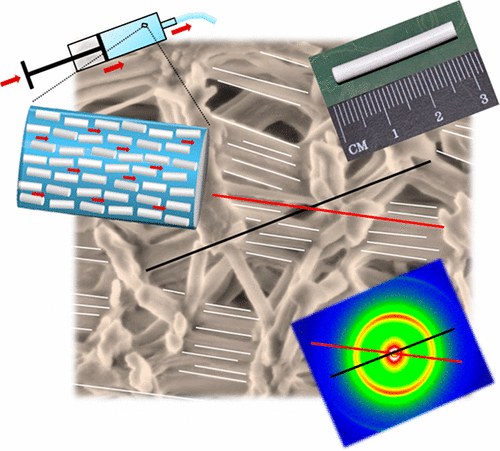当前位置:
X-MOL 学术
›
Chem. Mater.
›
论文详情
Our official English website, www.x-mol.net, welcomes your feedback! (Note: you will need to create a separate account there.)
Setting Directions: Anisotropy in Hierarchically Organized Porous Silica
Chemistry of Materials ( IF 8.6 ) Pub Date : 2017-09-15 00:00:00 , DOI: 10.1021/acs.chemmater.7b03032 Florian Putz 1 , Roland Morak 2 , Michael S. Elsaesser 1 , Christian Balzer 3 , Stephan Braxmeier 3 , Johannes Bernardi 4 , Oskar Paris 2 , Gudrun Reichenauer 3 , Nicola Hüsing 1
Chemistry of Materials ( IF 8.6 ) Pub Date : 2017-09-15 00:00:00 , DOI: 10.1021/acs.chemmater.7b03032 Florian Putz 1 , Roland Morak 2 , Michael S. Elsaesser 1 , Christian Balzer 3 , Stephan Braxmeier 3 , Johannes Bernardi 4 , Oskar Paris 2 , Gudrun Reichenauer 3 , Nicola Hüsing 1
Affiliation

|
Structural hierarchy, porosity, and isotropy/anisotropy are highly relevant factors for mechanical properties and thereby the functionality of porous materials. However, even though anisotropic and hierarchically organized, porous materials are well known in nature, such as bone or wood, producing the synthetic counterparts in the laboratory is difficult. We report for the first time a straightforward combination of sol–gel processing and shear-induced alignment to create hierarchical silica monoliths exhibiting anisotropy on the levels of both, meso- and macropores. The resulting material consists of an anisotropic macroporous network of struts comprising 2D hexagonally organized cylindrical mesopores. While the anisotropy of the mesopores is an inherent feature of the pores formed by liquid crystal templating, the anisotropy of the macropores is induced by shearing of the network. Scanning electron microscopy and small-angle X-ray scattering show that the majority of network forming struts is oriented towards the shearing direction; a quantitative analysis of scattering data confirms that roughly 40% of the strut volume exhibits a preferred orientation. The anisotropy of the material’s macroporosity is also reflected in its mechanical properties; i.e., the Young’s modulus differs by nearly a factor of 2 between the directions of shear application and perpendicular to it. Unexpectedly, the adsorption-induced strain of the material exhibits little to no anisotropy.
中文翻译:

设置方向:分层组织的多孔二氧化硅中的各向异性
结构层次,孔隙率和各向同性/各向异性是与机械性能以及多孔材料功能密切相关的因素。然而,即使各向异性且分等级地组织,多孔材料在自然界也是众所周知的,例如骨头或木头,在实验室中生产合成的对应物是困难的。我们首次报道了溶胶-凝胶加工和剪切诱导的排列方式的直接结合,以创建在中孔和大孔水平上均表现出各向异性的分层二氧化硅整体结构。所得材料由支杆的各向异性大孔网络组成,该支杆包含2D六角形组织的圆柱中孔。尽管介孔的各向异性是液晶模板形成的孔的固有特征,大孔的各向异性是由网络的剪切引起的。扫描电子显微镜和小角度X射线散射表明,大多数网络形成支杆都朝向剪切方向;散射数据的定量分析证实,大约40%的支撑杆体积表现出较好的方向。材料的大孔各向异性也反映在其机械性能上。也就是说,杨氏模量在施加剪切力的方向和垂直于剪切力的方向之间相差将近2倍。出乎意料的是,材料的吸附诱导应变几乎没有各向异性。散射数据的定量分析证实,大约40%的支撑杆体积表现出较好的方向。材料的大孔各向异性也反映在其机械性能上。也就是说,杨氏模量在施加剪切力的方向和垂直于剪切力的方向之间相差将近2倍。出乎意料的是,材料的吸附诱导应变几乎没有各向异性。散射数据的定量分析证实,大约40%的支撑杆体积表现出较好的方向。材料的大孔各向异性也反映在其机械性能上。也就是说,杨氏模量在施加剪切力的方向和垂直于剪切力的方向之间相差将近2倍。出乎意料的是,材料的吸附诱导应变几乎没有各向异性。
更新日期:2017-09-15
中文翻译:

设置方向:分层组织的多孔二氧化硅中的各向异性
结构层次,孔隙率和各向同性/各向异性是与机械性能以及多孔材料功能密切相关的因素。然而,即使各向异性且分等级地组织,多孔材料在自然界也是众所周知的,例如骨头或木头,在实验室中生产合成的对应物是困难的。我们首次报道了溶胶-凝胶加工和剪切诱导的排列方式的直接结合,以创建在中孔和大孔水平上均表现出各向异性的分层二氧化硅整体结构。所得材料由支杆的各向异性大孔网络组成,该支杆包含2D六角形组织的圆柱中孔。尽管介孔的各向异性是液晶模板形成的孔的固有特征,大孔的各向异性是由网络的剪切引起的。扫描电子显微镜和小角度X射线散射表明,大多数网络形成支杆都朝向剪切方向;散射数据的定量分析证实,大约40%的支撑杆体积表现出较好的方向。材料的大孔各向异性也反映在其机械性能上。也就是说,杨氏模量在施加剪切力的方向和垂直于剪切力的方向之间相差将近2倍。出乎意料的是,材料的吸附诱导应变几乎没有各向异性。散射数据的定量分析证实,大约40%的支撑杆体积表现出较好的方向。材料的大孔各向异性也反映在其机械性能上。也就是说,杨氏模量在施加剪切力的方向和垂直于剪切力的方向之间相差将近2倍。出乎意料的是,材料的吸附诱导应变几乎没有各向异性。散射数据的定量分析证实,大约40%的支撑杆体积表现出较好的方向。材料的大孔各向异性也反映在其机械性能上。也就是说,杨氏模量在施加剪切力的方向和垂直于剪切力的方向之间相差将近2倍。出乎意料的是,材料的吸附诱导应变几乎没有各向异性。



























 京公网安备 11010802027423号
京公网安备 11010802027423号